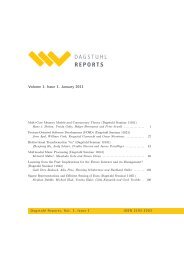Uncertainty modeling and analysis with intervals - DROPS - Schloss ...
Uncertainty modeling and analysis with intervals - DROPS - Schloss ...
Uncertainty modeling and analysis with intervals - DROPS - Schloss ...
Create successful ePaper yourself
Turn your PDF publications into a flip-book with our unique Google optimized e-Paper software.
52 11371 – <strong>Uncertainty</strong> <strong>modeling</strong> <strong>and</strong> <strong>analysis</strong> <strong>with</strong> <strong>intervals</strong>: . . .<br />
References<br />
1 F. Benhamou <strong>and</strong> L. Granvilliers. H<strong>and</strong>book of Constraint Programming, chapter Continuous<br />
<strong>and</strong> Interval Constraints. Elsevier 2004.<br />
2 A. Goldsztejn, Y. Lebbah, C. Michel, <strong>and</strong> M. Rueher. Capabilities of constraint programming<br />
in safe global optimization. Reliable computing 15(1):47–59, 2011.<br />
3 R. B. Kearfott. Interval <strong>analysis</strong>: Unconstrained <strong>and</strong> constrained optimization. Encyclopedia<br />
of Optimization, pages 1727–1730, 2009.<br />
4 P. Van-Hentenryck, D. McAllester, <strong>and</strong> D. Kapur. Solving polynomial systems using branch<br />
<strong>and</strong> prune approach. SIAM Journal on Numerical Analysis, 34(2):797–827, 1997.<br />
3.25 Managing uncertainty <strong>and</strong> discontinuous condition numbers in<br />
finite-precision geometric computation<br />
Peihui Shao (Université de Montréal, CA)<br />
License Creative Commons BY-NC-ND 3.0 Unported license<br />
© Peihui Shao<br />
Joint work of Shao, Peihui; Stewart, Neil<br />
Roundoff <strong>and</strong> representation errors in geometric computation may be modelled as epistemic<br />
or aleatory processes. In either case, if it is required that the computed result have correct<br />
topological form, then problems such as computing regularized Boolean operations are<br />
fundamentally ill-conditioned. In this paper it is shown that if we wish to drive the process<br />
through a discontinuity in the condition number, <strong>and</strong> if we wish to prove rigorous theorems,<br />
then use of an exception-h<strong>and</strong>ling mechanism analogous to those used in programming<br />
languages cannot be avoided.<br />
The above observations show that traditional approaches to proving robustness, when<br />
computation is done using ordinary IEEE floating-point arithmetic, are inappropriate. We<br />
discuss the nature, in the context described above, of the theorems that should be proved,<br />
<strong>and</strong> we give a very simple result that illustrates our approach.<br />
3.26 Reliable Kinetic Monte Carlo Simulation based on R<strong>and</strong>om Set<br />
Sampling<br />
Yan Wang (Georgia Institute of Technology, US)<br />
License Creative Commons BY-NC-ND 3.0 Unported license<br />
© Yan Wang<br />
The kinetic Monte Carlo (KMC) method has been widely used in simulating rare events such<br />
as chemical reactions or phase transitions. The lack of complete knowledge of transitions <strong>and</strong><br />
the associated rates is one major challenge for accurate KMC predictions. In this work, a<br />
reliable KMC (R-KMC) mechanism is developed to improve the robustness of KMC results,<br />
where propensities are interval estimates instead of precise numbers <strong>and</strong> sampling is based<br />
on r<strong>and</strong>om sets instead of r<strong>and</strong>om numbers. A multi-event algorithm is developed for event<br />
selection, <strong>and</strong> the system time is advanced based on best- <strong>and</strong> worst-case scenarios. The<br />
weak convergence of the multi-event algorithm towards traditional KMC is demonstrated<br />
<strong>with</strong> an interval master equation.













